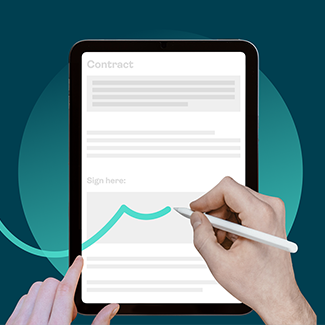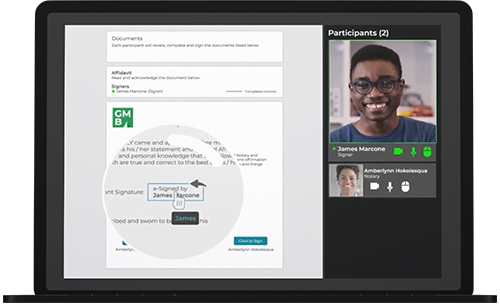The digital world has opened new possibilities to notaries. There are now multiple ways to securely complete a notarization. In this article, we break down the options, from remote online notarization to in-person electronic notarization, to guide you through this new landscape.
Overview of the three forms of online notarization: RON, RIN, and IPEN
There are three forms of online notarization: RON, RIN, and IPEN. Each differs slightly. At a high level, here are the differences:
- RON: Remote online notarization
RON allows the signer and notary to communicate face-to-face using audiovisual technology, thus eliminating the need for the notary and signer to be in the same location during the signing. - RIN: Remote ink-signed notarization
Similar to RON, RIN uses audiovisual technology that allows the signer and notary to meet remotely and communicate during the signing; however, RIN requires that the signer use pen and paper to sign the documents. The signer then mails the signed paper documents to the notary. - IPEN: In-person electronic notarization
IPEN differs the most from the other forms of online notarization. It requires the signer to appear in-person to complete the online notarization. The signing itself takes place using digital documents and electronic signatures.
Let’s explore each in more detail.
What is remote online notarization (RON)?
The process of notarizing documents remotely is known as remote online notarization (RON).
To notarize documents remotely, notaries use technology that ensures the identity of the people involved and the authenticity of their signature(s). Typically, RON technology includes electronic signatures, identity verification, and online-audio technology. During the signing, the notary and signer are not physically at the same location, however audio-visual technology facilitates anyone with internet access to join a video session to get their documents signed and notarized.
What are the steps for conducting RON?
More than 40 states have enacted permanent RON laws, including Florida, Nevada, Pennsylvania, Idaho, and Kansas. Each state has their own policy for conducting remote online notarizations, but they generally follow a similar process:
- The signer sends a request
In the request, the signer contacts the notary and requests the notarization of their document. The documents are uploaded in the form of a PDF.
- The signer's identity is validated
The process by which the notary confirms a signer's identity varies depending on state laws. Verification takes place in the form of knowledge-based authentication (KBA) and ID verification. Authentication is used prior to signing to reduce the risk of fraud and improve the customer's experience.
- The notarization takes place
When using RON technology, the notary and signer communicate using audiovisual technology. RON takes place remotely and the signing itself is completed electronically. Thus, the notary and signer are required to access an internet-connected computer, webcam, and microphone in order to notarize the documents.
- The notary reviews and captures additional information
After the document is signed and notarized, the notary can capture details of the notarization session in their eJournal.
What are the benefits of using RON?
Because the notarization process takes place entirely online, there are many advantages to using RON:
- Convenient for signers: Signers can participate in an online notary session from any location.
- Efficient: The notarization process is shortened since the signer and notary do not need to meet in person to conduct the signing.
- Secure: The possibility of identity fraud is reduced due to the measures taken to confirm the signer’s identity.
- Reduces risk: Eliminates the risk of post-closing errors, missing documents, missing signatures, and maintaining paper journals.
For more information, see the RON FAQ.
What is remote ink-signed notarization (RIN)?
Remote ink-signed notarization is the process by which the notary completes paper transactions without the traditional face-to-face signing. The remote signing process is recorded using audiovisual technology to ensure the validity of the ceremony.
What are the steps for conducting RIN?
RIN transactions became popular during the COVID-19 pandemic, because they allowed for documents to be notarized without the typical in-person signings. Now, many states still have temporary RIN laws, and the guidelines vary slightly depending on the state. But the four main steps are as follows:
- The signer receives hardcopy documents in the mail
RIN transactions do not take place in-person, thus the signer and notary public do not need to be in the same location. This remains a paper-based notarization, however. In order for a document to be notarized using RIN, the signer must sign the physical documents, which is why it is necessary to print and mail them. - An audio-video conference is held
Using technology such as, Zoom, Microsoft Teams, GoToMeeting, or WebEx, the signer and the notary communicate in real time. During the conference, the signing takes place. Rather than signing a digital document, RIN transactions occur when the signer notarizes the physical document. The videoconference session is recorded and logged by the notary to uphold the integrity of the process. - The signer's identity is verified
How the signer's identity is verified varies depending on the state. Typically, the signer will hold up their government-issued identity document (i.e., passport or driver’s license) to the webcam so the notary can compare it to the signer on-screen. - The wet-ink signature takes place and the documents are returned to the notary
A wet-ink signature happens when the signer physically signs the documents using pen and paper. Once the documents are signed, they are mailed to the notary who stamps them at a later date.
What are the benefits of using RIN?
RIN offers many benefits to the signers and notaries who use it, including:
- Convenient for signers: Notarizations are convenient and enable the notary to easily provide services to people who live far away.
- Saves time: It saves time and gas since people no longer need to physically travel to the notary’s office, but there is still the cost of paper, ink, and postage or courier charges.
- Easy: No special software is required. OneSpan provides a web-based solution, which makes it accessible to most.
What Is In-Person Electronic Notarization (IPEN)?
In-person electronic notarization is a notarization process in which the signer meets the notary at the same physical location and time that the notarization takes place. Thus, the signer’s physical presence is required at the time of the signing. However, the documents are presented in a digital format and are signed electronically. Though the applications for IPEN are varied, IPEN is commonly used in legal settings for notarial acts.
What are the steps to conducting IPEN?
Like RON and RIN, steps for IPEN notarization vary depending on the state but follow the same general guidelines.
- The documents are digitally uploaded and reviewed by the notary
Before the signing commences, the notary loads the documents into a digital format. The notary then reviews the documents. Any last-minute changes will be updated prior to the signing ceremony. - The signing takes place
The signer and notary meet in the same location to complete the signing. The signer's identity is validated using the same measures as a traditional notarization process. After the signer’s identity is validated, they eSign the document and the notary affixes their electronic notary seal to complete the notarization. - The notary reviews and captures additional information
After the document is signed and notarized, the notary can capture details of the e-notarization session in their eJournal.
What are the benefits of IPEN?
IPEN can be an effective and efficient notarization process and offers many benefits over the standard in-person notarization:
- Secure: During the signing process, OneSpan applies digital signatures after each signature to provide tamper-evident documents. In addition, notarized documents and data are encrypted in transit and at rest.
- Reduces risk: Eliminates the risk of post-closing errors, missing documents, missing signatures, and maintaining paper journals.
- Easy: No special software is required. OneSpan provides a web-based solution, which makes it accessible to most.
- Immediate: Updates to electronic documents can be executed instantly.
- No paper consumption: Using digital documents and electronic records eliminates paper waste.
Where can IPEN be used?
In the US, OneSpan Notary is IPEN-approved and compliant in more than 30 states, including Arizona, New York, Montana, Washington, West Virginia, Michigan, New Jersey, and Minnesota.
In Canada, IPEN regulation is in place for all provinces except Quebec. The regulation is the Canada Online Notarization Model Act. Therefore, OneSpan Notary can be used for the IPEN use case in all but one Canadian province.
In the UK, e-notarization is governed by the Electronic Identification and Trust Services for Electronic Transactions Regulations 2016 (eIDAS). This allows in-person notarisation using a qualified electronic signature in order to be legally binding and recognized in the UK and all EU member states. A qualified electronic signature is essentially an advanced electronic signature backed by a digital certificate. The digital certificate is issued by a third-party trust service provider to ensure the individual signing is who they claim to be.
The future of online notarization
Online notarization is relatively new to both the notary public and the notarization process. It became increasingly popular because of the COVID-19 pandemic. Adhering to social-distancing orders, notary services were not provided in person, which prompted many states to craft temporary laws that outlined the enotary process. While the role that technology plays in the process differs from traditional notarizations, all follow the same general standards.
Analysts have reported that now is the right time for remote online notarization to flourish, with lenders indicating that they would be comfortable conducting virtual transactions such as loan closing using remote online notarization.
A wide variety of use cases are emerging for electronic notarial acts in all forms (RON, RIN, and IPEN) with the requirement for security establishing itself as the common denominator. Indeed, there are tremendous opportunities for lenders and other users in automotive sales, estate planning, wealth, insurance, and healthcare.
Download this Javelin report to learn how to identify a RON provider with mature technology capabilities, and the expertise to evolve as the regulatory environment changes.








